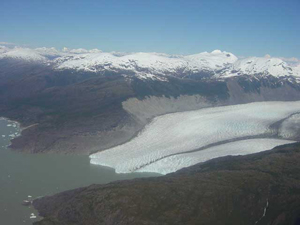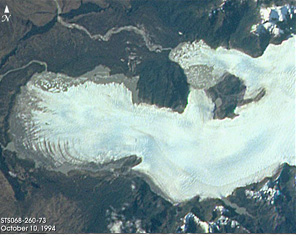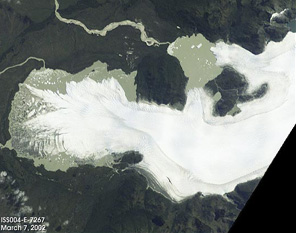 |
 |
 |
 |
 |
 |
 |
 |
 |
 |
|
|
Home > Environmental issues > Article |
|
 South American glaciers melting faster, changing sea levelNASA Press Release October 16 2003The Patagonia Icefields of Chile and Argentina, the largest non-Antarctic ice masses in the Southern Hemisphere, are thinning at an accelerating pace. They now account for nearly 10 percent of global sea-level change from mountain glaciers, according to a new study by NASA and Chile's Centro de Estudios Cientificos. Results of the study, published in the journal Science, conclude that the Patagonia Icefields lost ice at a rate equivalent to a sea level rise of 0.04 millimeters (0.0016 inches) per year during the period 1975 through 2000. This is equal to nine percent of the total annual global sea-level rise from mountain glaciers, according to the 2001 Intergovernmental Panel on Climate Change Scientific Assessment. From 1995 through 2000, however, that rate of ice loss from the icefields more than doubled, to an equivalent sea level rise of 0.1 millimeters (0.004 inches) per year. |
||||
|

|
Alaska's glaciers, which cover an area five times larger than the Patagonia glaciers, account for about 30 percent of total annual global sea-level rise from mountain glaciers. NASA scientists have concluded that the cause of glacial retreat is climate change, as evidenced by increased air temperatures and decreased precipitation. Still, those factors alone are not sufficient to explain the rapid thinning. The rest of the story appears to lie primarily in the unique dynamic response of the region's glaciers to climate change. The Patagonia Icefields are dominated by 'calving' glaciers, that spawn icebergs into the ocean or lakes, and have different dynamics from glaciers that end on land and melt at their front ends. Calving glaciers are more sensitive to climate change once pushed out of equilibrium, and make the Patagonia region the fastest area of glacial retreat on Earth. The Northern Patagonia Icefield in Chile and the Southern Patagonia Icefield in Chile and Argentina, cover 13,000 and 4,200 sq. km (5,019 and 1,622 sq. miles), respectively. The region, spanning the Andes mountain range, is sparsely inhabited, with rough terrain and poor weather. Precipitation in the region ranges from 2 to 11 meters (6.6 to 36 feet) of water equivalent per year, a snow equivalent of up to 30 meters (98.4 feet) a year. The icefields discharge ice and meltwater to the ocean on the west side and to lakes on the east side, via rapidly flowing glaciers. The fronts of most of these glaciers have been retreating over the past half-century or more. |
||
 |
||
 |
||
 |
Copyright © 2003 - 2006 TerraNature Trust. All rights reserved.
home | sponsors |
latest news & events |
join - donate |
contact information | projects |
 Melting Arctic summer sea ice reaches lowest level
Melting Arctic summer sea ice reaches lowest level


 View larger image
View larger image